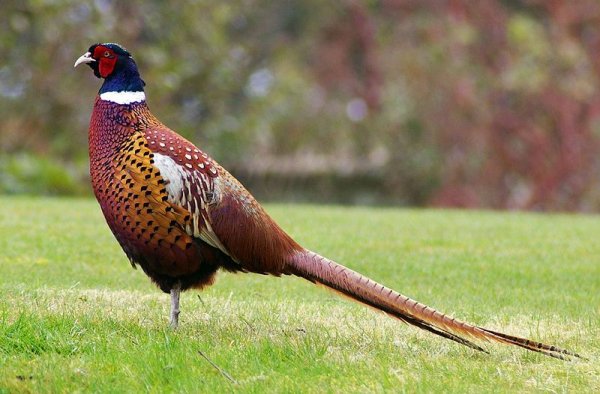Galliformes are an order of heavy-bodied ground-feeding
domestic or game bird, containing turkey,
grouse,
chicken,
New and Old World Quail, ptarmigan, partridge,
pheasant,
and the
Cracidae.
Common names are gamefowl or gamebirds,.
landfowl, gallinaceous birds or galliforms. "Wildfowl"
or just "fowl" are also often used for
Galliformes,
but usually these terms
also refer to waterfowl (
Anseriformes),
and occasionally to other commonly hunted birds.
This group has about
290 species, one or more of which
are found in essentially every part of the world's continents
(except for
the innermost deserts and perpetual ice). They are more rare
on islands, and in contrast to the closely related waterfowl
are
essentially absent from oceanic islands—except if introduced
there by humans. Several species have been domesticated during
their long and extensive relationship with humans.
This order contains
five families: Phasianidae (including
chicken, quail, partridges, pheasants, turkeys, and grouse),
Odontophoridae (New World quails), Numididae (guineafowl),
Cracidae (including chachalacas and currasows), and
Megapodiidae (incubator birds like mallee fowl and brush-turkeys).
They are important as seed dispersers and predators in the
ecosystems they inhabit and are often reared as game birds
by humans for meat and egg consumption and for recreational
hunting.
All are skilled runners that can fly only a few hundred feet
when escaping danger. Males of most species are more colorful
than
the females. Males often have elaborate courtship behaviors
that include strutting, fluffing of tail or head feathers,
and vocal sounds.
They are mainly non-migratory birds.
Gallinaceous birds feed on a variety of plant and animal material,
which may include fruits, seeds, leaves, shoots, flowers,
tubers,
roots, insects, snails, worms, lizards, snakes, small rodents,
and eggs.
Most of the galliform birds are more or less resident, but
some of the smaller temperate species (such as quail) do
migrate
over
considerable distances. Altitudinal
migration
is evidently quite common amongst montane species and a few
species of subtropical
and subarctic regions must reach their watering and/or foraging
areas through sustained flight. Species known to make extensive
flights include the ptarmigans, sage-grouse (Centrocercus),
Crested Partridge, Green Peafowl, Crested Argus, Mountain
Peacock-
Pheasant,
Polyplectron inopinatum, Koklass Pheasant,
Pucrasia macrolopha, Reeves's Pheasant,
Syrmaticus
reevesii and
Green Junglefowl,
Gallus varius. Other species—most
of the New World quails (also known as the toothed quails),
the enigmatic Stone Partridge,
Ptilopachus petrosus
of Africa, guineafowl and eared pheasants,
Crossoptilon—are
all notable
for their daily excursions on foot which may take them many
miles in a given day.
Some Galliformes are adapted to grassland habitat, and these
genera are remarkable for their long, thin necks, long legs
and large,
wide wings. Fairly unrelated species like the Crested Fireback,
Lophura ignita, Vulturine Guineafowl,
Acryllium
vulturinum,
and Malleefowl, Leipoa ocellata, are outwardly similar
in their body types.
Source: http://en.wikipedia.org/wiki/Phasianoidea







